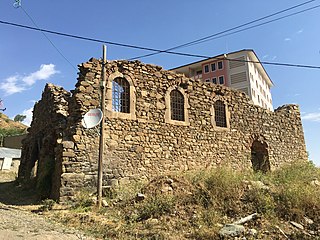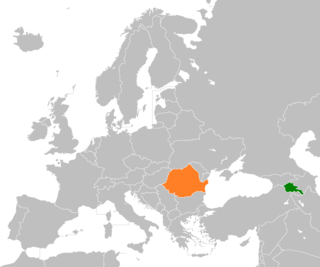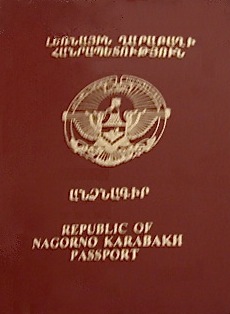Dariunq was a region of the old Armenia c. 300-800 ruled by the Bagratuni family.
Dariunq was a region of the old Armenia c. 300-800 ruled by the Bagratuni family.

Armenian is an Indo-European language and the sole member of the independent branch of the Armenian language family. It is the native language of the Armenian people and the official language of Armenia. Historically spoken in the Armenian highlands, today Armenian is also widely spoken throughout the Armenian diaspora. Armenian is written in its own writing system, the Armenian alphabet, introduced in 405 AD by Saint Mesrop Mashtots. The estimated number of Armenian speakers worldwide is between five and seven million.

Eastern Armenian is one of the two standardized forms of Modern Armenian, the other being Western Armenian. The two standards form a pluricentric language.

Armenians are an ethnic group and nation native to the Armenian highlands of West Asia. Armenians constitute the main population of Armenia and constituted the main population of the breakaway Republic of Artsakh until the 2023 Azerbaijani offensive in Nagorno-Karabakh and the subsequent flight of Nagorno-Karabakh Armenians. There is a wide-ranging diaspora of around five million people of full or partial Armenian ancestry living outside modern Armenia. The largest Armenian populations today exist in Russia, the United States, France, Georgia, Iran, Germany, Ukraine, Lebanon, Brazil, Argentina, Syria, and Turkey. The present-day Armenian diaspora was formed mainly as a result of the Armenian genocide with the exceptions of Iran, former Soviet states, and parts of the Levant.

The Cathedral of Saint James is a 12th-century Armenian church in the Armenian Quarter of Jerusalem, near the quarter's entry Zion Gate. The cathedral is dedicated to two of the Twelve Apostles of Jesus: James, son of Zebedee and James the brother of Jesus. It is located near the Church of the Holy Archangels.

Bgheno-Noravank is an 11th-century Armenian monastery in the province of Syunik in Armenia, 3km to the East of Bardzravan village, to the left of the road to Shurnukh, on a triangular promontory surrounded by wooded gorges. It now consists of a small church dating to 1062, located on a little wooded promontory, and ornately decorated with borders and biblical reliefs. The ruins of this church were rediscovered in the 1920s by Axel Bakunts, a well-known prose writer, during one of his wanderings as an agronomist.

Many Armenian merchants from Amsterdam went to Southeast Asia in the 19th century to trade, and to set up factories and plantations. Armenian merchants settled in parts of Java, then part of the Dutch East Indies, as did Armenians moving east from the Persian Empire, establishing a community of Armenians in Java.

The Ararat Plain, called Iğdır Plain in Turkey, is one of the largest plains of the Armenian Highlands. It stretches west of the Sevan basin, at the foothills of the Gegham mountains. In the north, the plain borders on Mount Aragats, and Mount Ararat in the south.
The Armenia men's national tennis team represents Armenia in Davis Cup tennis competitions and are governed by the Armenian Tennis Federation.

Armenia, officially the Republic of Armenia, is a landlocked country in the Armenian Highlands of West Asia. It is a part of the Caucasus region and is bordered by Turkey to the west, Georgia to the north and Azerbaijan to the east, and Iran and the Azerbaijani exclave of Nakhchivan to the south. Yerevan is the capital, largest city and financial center.
There are various systems of romanization of the Armenian alphabet.

Surp Marineh Church was one of eight churches existing in town of Moush before the Armenian genocide. Surp Marineh was the most notable church in whole Tarawn region of Historical Armenia, and was known as "Katoghike". Currently it is in a ruinous state and only parts of the outer walls still stand.
Stepanavan Airport is a civil airport serving the city of Stepanavan and the province of Lori, in the country of Armenia. The airport was built in the early 1970s and has since undergone several renovations to improve its facilities and services. It is located 6 km (3.7 mi) northwest of the center of Stepanavan.

Armenia–Romania relations refer to the bilateral relations between Armenia and Romania. Both countries established diplomatic relations on 17 December 1991. Armenia has an embassy in Bucharest and Romania has an embassy in Yerevan. Both countries are members of the Organization of the Black Sea Economic Cooperation and the Council of Europe.

Armenia Time is a time zone used in Armenia. Armenia Time is four hours ahead of UTC at UTC+04:00.

The Statistical Committee of Armenia, or ArmStat in short, is the national statistical agency of Armenia.

Ganchvor Sourp Asdvadzadzin is the Armenian Apostolic church in Famagusta, Cyprus.
Armenian Sign Language is the deaf sign language of Armenia.

Artsakhi passports were issued to Artsakhi citizens to travel outside the partially recognized Republic of Artsakh. They were also used as proof of identity within the country. Passports of the Republic of Artsakh were issued based on amendments to the Constitution of Artsakh of 2006.
The Holy Trinity Church or Surp Yerrortut'yun Church is a historical Armenian Apostolic temple in the former Armenian quarter called Hoshnudiye of the Western Turkish town of Eskishehir. It was turned into an adult theater after the Armenians of the town were deported and killed during the Armenian genocide.

The Holy Trinity Church or Surp Yerrortut'yun Church is a historical Armenian Apostolic temple in the former Armenian quarter of Sivrihisar in the western Turkish province of Eskişehir. It was used as a store after the Armenians of the town had been deported and killed during the Armenian genocide. It is one of the biggest churches in Anatolia.